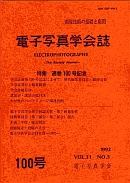Volume 36, Issue 3
Displaying 1-7 of 7 articles from this issue
- |<
- <
- 1
- >
- >|
Original Articles
-
1997Volume 36Issue 3 Pages 142-149
Published: 1997
Released on J-STAGE: April 06, 2007
Download PDF (1129K) -
1997Volume 36Issue 3 Pages 150-157
Published: 1997
Released on J-STAGE: April 06, 2007
Download PDF (1612K) -
1997Volume 36Issue 3 Pages 158-162
Published: 1997
Released on J-STAGE: April 06, 2007
Download PDF (994K)
Imaging Today
“Science in Particle Motion”
“Science in Particle Motion”
-
1997Volume 36Issue 3 Pages 164-168
Published: 1997
Released on J-STAGE: April 06, 2007
Download PDF (1796K) -
1997Volume 36Issue 3 Pages 169-174
Published: 1997
Released on J-STAGE: April 06, 2007
Download PDF (1444K) -
1997Volume 36Issue 3 Pages 175-184
Published: 1997
Released on J-STAGE: April 06, 2007
Download PDF (2109K) -
1997Volume 36Issue 3 Pages 185-195
Published: 1997
Released on J-STAGE: April 06, 2007
Download PDF (4526K)
- |<
- <
- 1
- >
- >|
